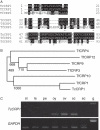Identification and characterization of TcCRP1, a pollen tube attractant from Torenia concolor
- PMID: 21546430
- PMCID: PMC3170153
- DOI: 10.1093/aob/mcr111
Identification and characterization of TcCRP1, a pollen tube attractant from Torenia concolor
Abstract
Background and aims: During sexual reproduction in higher angiosperms, the pollen tubes are directed to the ovules in the pistil to deliver sperm cells. This pollen tube attraction is highly species specific, and a group of small secreted proteins, TfCRPs, are necessary for this process in Torenia fournieri.
Methods: A candidate pollen tube attractant protein in Torenia concolor, a related species of T. fournieri, was isolated and the attractant abilities between them were compared.
Key results: TcCRP1, an orthologous gene of TfCRP1 from T. concolor, is expressed predominantly in the synergid cell. The gene product attracted pollen tubes in a concentration-dependent manner, but attracted fewer pollen tubes from the other species.
Conclusions: The results indicated that this class of CRP proteins is a common pollen tube attractant in Torenia species. The sequence diversity of these proteins is important for species-specific pollen tube attraction.
Figures





Similar articles
-
Species preferentiality of the pollen tube attractant derived from the synergid cell of Torenia fournieri.Plant Physiol. 2006 Oct;142(2):481-91. doi: 10.1104/pp.106.083832. Epub 2006 Aug 25. Plant Physiol. 2006. PMID: 16935992 Free PMC article.
-
A species-specific cluster of defensin-like genes encodes diffusible pollen tube attractants in Arabidopsis.PLoS Biol. 2012;10(12):e1001449. doi: 10.1371/journal.pbio.1001449. Epub 2012 Dec 18. PLoS Biol. 2012. PMID: 23271953 Free PMC article.
-
Acquisition of LURE-binding activity at the pollen tube tip of Torenia fournieri.Mol Plant. 2013 Jul;6(4):1074-90. doi: 10.1093/mp/sst050. Epub 2013 Mar 12. Mol Plant. 2013. PMID: 23482369
-
Pollen tube guidance by attractant molecules: LUREs.Cell Struct Funct. 2010;35(1):45-52. doi: 10.1247/csf.10003. Cell Struct Funct. 2010. PMID: 20562497 Review.
-
Gametophytic Pollen Tube Guidance: Attractant Peptides, Gametic Controls, and Receptors.Plant Physiol. 2017 Jan;173(1):112-121. doi: 10.1104/pp.16.01571. Epub 2016 Dec 5. Plant Physiol. 2017. PMID: 27920159 Free PMC article. Review.
Cited by
-
Species-specific interaction of EA1 with the maize pollen tube apex.Plant Signal Behav. 2013 Oct;8(10):doi: 10.4161/psb.25682. doi: 10.4161/psb.25682. Plant Signal Behav. 2013. PMID: 23887497 Free PMC article.
-
Whole-mount RNA in situ hybridization technique in Torenia ovules.Plant Reprod. 2023 Jun;36(2):139-146. doi: 10.1007/s00497-022-00455-2. Epub 2022 Dec 21. Plant Reprod. 2023. PMID: 36543964
-
A subunit of the oligosaccharyltransferase complex is required for interspecific gametophyte recognition in Arabidopsis.Nat Commun. 2016 Mar 11;7:10826. doi: 10.1038/ncomms10826. Nat Commun. 2016. PMID: 26964640 Free PMC article.
-
A Complex Journey: Cell Wall Remodeling, Interactions, and Integrity During Pollen Tube Growth.Front Plant Sci. 2020 Nov 30;11:599247. doi: 10.3389/fpls.2020.599247. eCollection 2020. Front Plant Sci. 2020. PMID: 33329663 Free PMC article. Review.
-
Male gametophyte development and function in angiosperms: a general concept.Plant Reprod. 2016 Jun;29(1-2):31-51. doi: 10.1007/s00497-015-0272-4. Epub 2016 Jan 4. Plant Reprod. 2016. PMID: 26728623 Review.
References
-
- Amien S, Kliwer I, Marton ML, et al. Defensin-like ZmES4 mediates pollen tube burst in maize via opening of the potassium channel KZM1. PLoS Biology. 2010;8:e1000388. doi:10.1371/journal.pbio.1000388. - DOI - PMC - PubMed
-
- Bendtsen JD, Nielsen H, von Heijne G, Brunak S. Improved prediction of signal peptides: SignalP 3·0. Journal of Molecular Biology. 2004;340:783–795. - PubMed
-
- Chapman LA, Goring DR. Pollen–pistil interactions regulating successful fertilization in the Brassicaceae. Journal of Experimental Botany. 2010;61:1987–1999. - PubMed
-
- Cornet B, Bonmatin JM, Ptak M, Vovelle F. Refined 3-dimensional structure of insect defensin A in water from NMR data. Journal of Trace and Microprobe Techniques. 1995;13:335–336.
Publication types
MeSH terms
Substances
Associated data
- Actions
LinkOut - more resources
Full Text Sources
Research Materials
Miscellaneous

